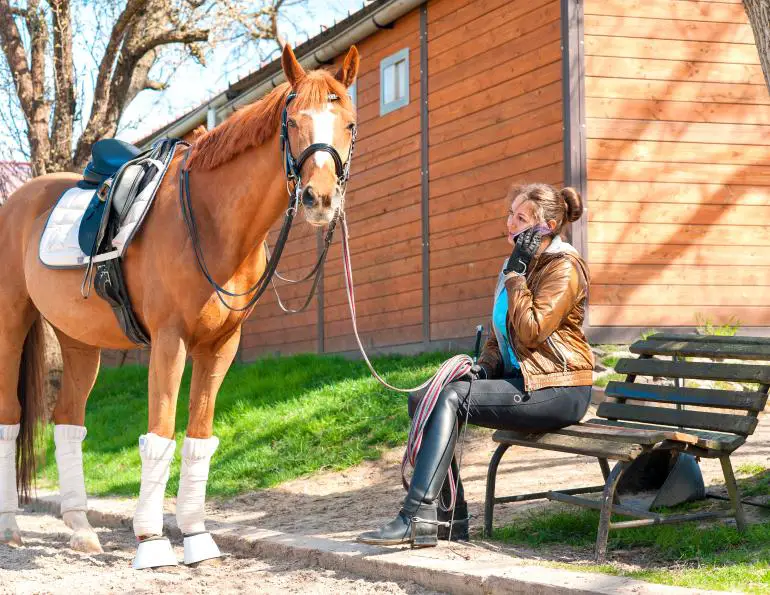How do horse leases work? A horse lease is an agreement between the owner and another individual, typically referred to as the lessee. The purpose of a horse lease is for the lessee to have exclusive rights to ride and care for the horse during an agreed-upon period, such as one year or longer. A written contract outlines all terms of the agreement including specifics about which party pays for what related to food, supplies, veterinary bills, etc.
Generally speaking, the lessee pays monthly fees in exchange for the use of a particular horse and may be responsible for providing basic needs such as feed, hay and bedding. Riding privileges are generally laid out in this document too; some leases include showing opportunities at competitions or events while others limit riding activities solely to recreational purposes.
Horse leasing is an increasingly popular way to enjoy the companionship of a horse without having to fully commit to owning one. A lease usually involves a short-term contract between the owner of the horse and the lessee, in which the owner allows the use of his/her horse for an agreed-upon fee. This arrangement can give both parties benefits – for example, it could provide someone with experience in handling horses who wants more than occasional rides but doesn’t have enough money or space to buy their own animal, as well as giving owners additional income and relief from some work associated with ownership.
In most cases, owners are responsible for providing food and vet care while lessees take on all other costs like tack (saddles, bridles, etc.) and farrier fees. It is important that both parties understand their rights and responsibilities before entering into any agreement so that expectations are clear from the start.
How to Negotiate a Horse Lease
Negotiating a horse lease can be an intimidating process for both the leaser and lessee. It is important to make sure that all parties involved are comfortable with the terms of the agreement and that everyone has a clear understanding of their responsibilities. Before entering into negotiations, each party should have in writing what they expect out of the lease, such as duration and cost, as well as any health requirements or special needs for either animal or rider.
Once these expectations are laid out, it’s time to talk money – work together to come up with a price that works for both sides. Additionally, consider if you want to include additional clauses such as insurance coverage and legal protections. With proper preparation and communication, negotiating a horse lease can be successful!
Is It Cheaper to Own Or Lease a Horse?
Owning a horse is typically cheaper than leasing one, in the long run. While it may cost more upfront to purchase a horse outright, the long-term costs are lower than those associated with leasing. Not only do you avoid paying monthly lease fees, but you also don’t have to worry about additional expenses like transportation or show entry fees that might come with having a leased horse.
Additionally, when you own your own horse, you can take advantage of tax deductions and other savings that aren’t available when leasing. When owning your own horse, there will still be expenses such as feed and vet bills; however, they’re much less expensive on average compared to what comes along with leasing horses. It’s important to remember too that if something happens to your leased animal it doesn’t affect you financially since the ownership isn’t yours; whereas if something happens while an owned animal is under your care then there could be financial repercussions for which you would be liable for any repair or medical costs incurred.
All things considered though, owning a horse has numerous benefits over leasing one and will generally end up being much cheaper in the long run!
How Does a Lease Work on a Horse?
When it comes to owning a horse, many people opt for leasing instead of buying. A lease is an agreement between two parties that allows one person (the lessee) to use the horse belonging to another (the lessor). Leasing involves a monthly fee and usually lasts for 6 months or 1 year.
The lessor retains ownership of the horse but provides care and upkeep throughout the duration of the lease period. Depending on the specifics outlined in the contract, some leases may also include board fees if you need assistance with feeding and stabilizing your leased horse. These fees vary from owner to owner and should be discussed before signing any agreement.
Generally speaking, most leases involve setting specific goals such as attending shows or working towards achieving certain awards – this helps motivate both parties during their time together! It’s important that both sides have clear expectations about what kind of riding will take place during their time together so everyone is on the same page when it comes to caring for their leased equine partner.
Who Pays Vet Bills When You Lease a Horse?
When you lease a horse, there are several factors to consider when it comes to who pays for the veterinary bills. Generally speaking, the person leasing the horse is responsible for covering any veterinarian expenses incurred during the course of their lease agreement. However, depending on the type and length of lease that has been negotiated between both parties involved in the transaction, this may not always be true.
For example, if an individual takes out a long-term lease lasting more than 12 months then they may be entitled to some form of financial contribution from their lessor towards their vet bills. In addition to this, certain agreements may also stipulate that all costs related to medical care and treatments should be shared equally between both parties or at least split according to what is agreed upon by each party upfront. Ultimately, it is important for those entering into such an arrangement with a horse owner or stable manager to ensure that they have read through all terms and conditions carefully before signing anything so as not to get caught out later down the line with unexpected veterinary bills!
What Should Be Included in a Horse Lease Agreement?
A horse lease agreement should include the expectations of both parties involved in the lease. It should clearly state who will be responsible for providing feed, hay, bedding and other necessities as well as outlining any responsibilities that may come up during the term of the lease such as turnout or vet care. It is also important to include how much time each party can spend with the horse, including riding times and grooming hours.
The agreement should also detail what type of activities are allowed while using the leased horse, like showing at competitions or giving lessons to others on it. Additionally, insurance information must be included in a horse lease agreement to ensure that both parties are properly protected from liability issues in case an accident occurs involving either party or their property; this includes naming all riders who may use the leased horse during its period of use. Lastly, termination clauses need to be outlined so that both parties understand when and why a particular lease might end prematurely due to unforeseen circumstances such as injury or illness of either party involved or financial hardship.
Leasing a Horse: Pros and Cons
Conclusion
Horse leasing can be a great option for those who want to own and experience the joy of caring for a horse, but don’t necessarily have the financial capacity or long-term commitment to buy one. From full leases to shared leases, there are many options available that fit any budget or lifestyle. It is important to do your research and find an arrangement that works best for you.
With some hard work and dedication, horse leasing can be a rewarding experience both financially and emotionally!
Janet G Kulick is an experienced horse rider, trainer, and owner of the informative horse blog, Horseray.com. Her engaging writing style and wealth of knowledge on horse care, riding, and training make her a trusted source for horse enthusiasts worldwide.






